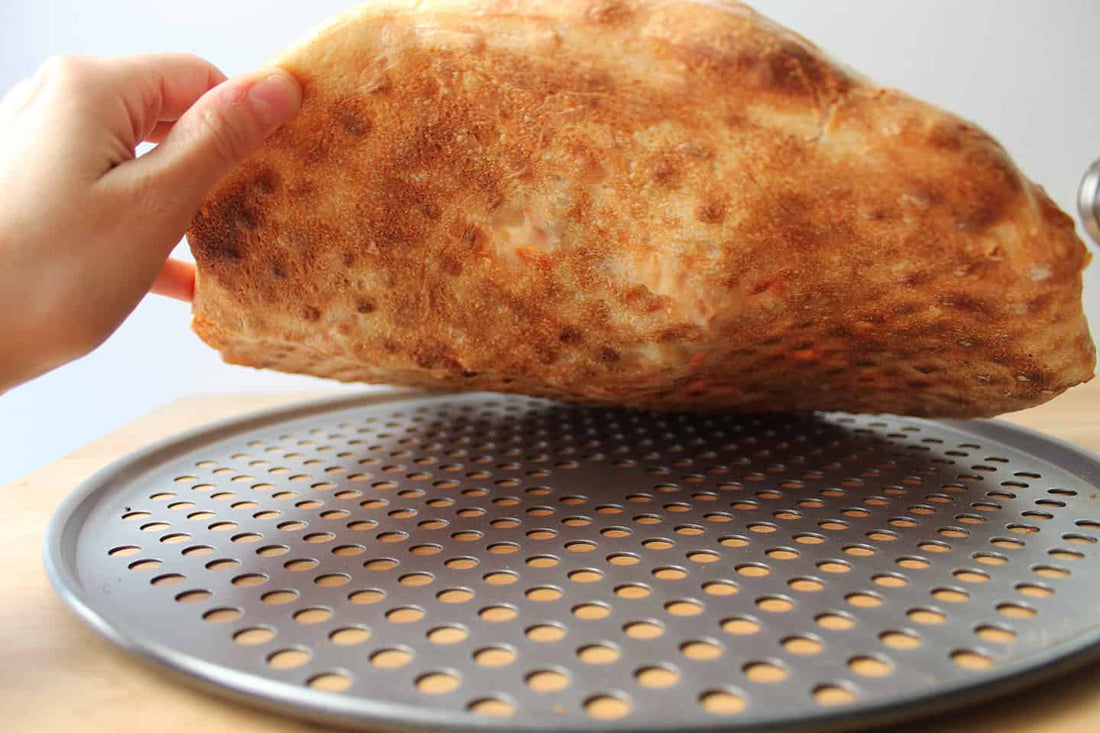A pizza pan is an essential kitchen tool that can transform your homemade pizza experience, delivering the perfect crust and bake every time. Whether you’re a professional chef or a home cook, understanding the types, materials, and features of pizza pans can help you achieve restaurant-quality pizza right in your oven. From thin, crispy crusts to deep-dish delights, the right pizza pan influences baking time, heat distribution, and ultimately the texture and flavor of your pizza.
What Is a Pizza Pan?
A pizza pan is a specialized baking pan designed specifically for making pizzas. It is typically a flat, round metal tray with a slightly raised edge to hold the dough and toppings. The pan’s design helps transfer heat evenly to the pizza crust, influencing how crispy or soft the crust becomes during baking. Pizza pans can vary in material commonly aluminum, steel, or cast iron and may have a solid, perforated, or textured surface to affect airflow and moisture release, which in turn impacts crust texture. Some pizza pans have holes or a mesh bottom to allow better heat circulation, mimicking the effect of a pizza stone for a crispier crust. The height of the pan’s rim can also vary depending on the style of pizza, from thin crust to deep dish. Overall, a pizza pan is an essential tool for baking pizzas at home or in commercial kitchens, designed to optimize baking time, heat distribution, and crust quality

Why Choosing the Right Pizza Pan Matters
Choosing the right pizza pan matters because it directly affects the texture, baking time, and overall quality of your pizza. The pan’s material, thickness, and surface design influence how heat is distributed and retained, which determines whether your crust turns out crispy, chewy, or soggy. For example, thicker pans absorb and retain heat better, ensuring even cooking and a nicely crisped bottom, while thinner pans heat up faster but may cause uneven baking or warping under high temperatures.
The surface style of the pan also plays a crucial role: perforated pans allow airflow beneath the crust, promoting a crispier base, while solid pans provide more stability and a softer crust. This choice depends on the crust texture you prefer.
For restaurants, the right pizza pan improves kitchen efficiency by enabling faster, more consistent baking and better customer satisfaction. For home cooks, it helps replicate the crispy, oven-style pizza crust often hard to achieve in a conventional oven. Using a quality pan also helps retain toppings’ moisture while preventing sogginess, resulting in a balanced, flavorful pizza
Types of Pizza Pans
| Type | Description | Best For |
|---|---|---|
| Pizza Stone | Ceramic or cordierite, mimics brick oven | Crispy artisan crust |
| Cast Iron Pizza Pan | Excellent heat retention, stovetop compatible | Thick crust, outdoor grilling |
| Pizza Screen | Mesh bottom allows airflow for quick baking | Thin crust, conveyor ovens |
| Deep Dish Pizza Pan | High edges to hold sauce and cheese | Chicago-style pizza |
| Detroit Style Pizza Pan | Deep rectangular pan with caramelized edges | Detroit-style pizza |
| Cutter Pizza Pan | Slightly curved walls for easy serving | Commercial kitchens |
| Coupe / Flat Pan | Versatile, bake, cut, and serve on same pan | General-purpose baking |
| Wide Rim Pizza Pan | Easy to handle, doubles as serving tray | Restaurants |
Material Highlights
- Aluminum pans heat quickly and evenly, are lightweight and affordable, but may warp and produce a less crisp crust.
- Steel pans (including aluminized or blue/black steel) offer excellent heat conduction and durability, often preferred in commercial settings.
- Cast iron pans retain heat exceptionally well, ideal for thick crusts and grilling.
- Pizza stones and steels mimic traditional brick oven results by absorbing moisture and providing intense, even heat.
Choosing the right type depends on your preferred pizza style and baking method. For example, a perforated pizza screen is excellent for thin crusts, while a deep dish pan is necessary for Chicago-style pizzas. Pizza stones and steels are favored for artisan-style pizzas seeking a crispy, evenly baked crust.
By selecting the appropriate pizza pan, you can optimize baking time, crust texture, and overall pizza quality.

Pizza Pan Surface Styles – Solid vs Perforated
- Solid Pizza Pan: No holes, slower bake, softer crust.
- Nibbed Pizza Pan: Raised bumps to allow airflow beneath dough.
- Perforated Pizza Pan: Small holes for faster bake and crispier crust.
- Super-Perforated Pizza Pan: Extra ventilation for the thinnest crusts.
Using a perforated pizza pan helps mimic the airflow of a pizza stone, achieving a brick oven-style crust in a conventional oven.
Pizza Pan Materials and Thickness
| Material | Features | Use Case |
|---|---|---|
| Aluminum | Lightweight, fast heat transfer | Thin crust, quick bake |
| Anodized Aluminum | Hard, corrosion-resistant | Heavy use, commercial kitchens |
| Cast Iron | High heat retention | Deep dish, thick crust, grilling |
| Tin-Plated Steel | Affordable, rusts if uncoated | Occasional use |
| Aluminized Steel | Durable, corrosion-resistant | Professional kitchens |
Thicker, heavy-gauge pans resist warping and retain heat longer, while lighter pans bake faster but may warp under high heat.
Pan Coatings vs Finishes
- Dark Coated Pans: Absorb more heat, produce darker, crispier crusts.
- Light Coated Pans: Reflect heat, resulting in softer crusts.
- Hard Coat Anodized: Durable and resistant to chipping.
- Silicone Glazed: Naturally non-stick and easy to clean.
Choosing the right finish balances crust color and baking time depending on your oven type and pizza style.
By understanding the variety of pizza pans available and their unique characteristics, you can select the perfect pan to suit your cooking style and pizza preferences. Whether aiming for a thin, crispy crust or a hearty deep-dish, the right pizza pan is your first step toward pizza perfection.
Pizza Pan Sizes – Which One to Choose?
Pizza pans come in a variety of sizes to suit different baking needs, from personal pizzas to large family or commercial servings. The most common standard round pan sizes range from 8 inches to 18 inches in diameter, including 8”, 10”, 12”, 14”, 16”, and 18” pans. Each size affects the pizza’s crust thickness and baking time: smaller pans yield thicker, chewier crusts, while larger pans allow the dough to stretch thinner and bake crisper.
For Detroit-style pizzas, rectangular pans are typical, with sizes like 8x10 inches or 10x14 inches, designed to create the signature thick, caramelized edges.
Use Cases by Size
- Small pans (8–10 inches): Ideal for personal pizzas or small ovens. These are perfect for individual servings or when customizing pizzas with different toppings.
- Medium pans (12–14 inches): The most popular size for families, serving 2 to 4 people. These pans fit standard frozen pizzas and work well for everyday home baking.
- Large pans (16–18 inches): Suitable for gatherings or commercial kitchens. Larger pans produce thinner, crispier crusts but require ovens that can accommodate their size.
- Rectangular or specialty pans: Used for styles like Detroit or Sicilian pizzas, offering more surface area and deeper sides for thick crusts and hearty toppings.
When selecting a pan, consider your oven size, the number of servings needed, and the pizza style you prefer. Allow at least 2 inches of space around the pizza for proper dough rise and airflow during baking.
Use Cases: Best Pan for Each Pizza Type
| Pizza Style | Best Pan Type | Key Traits |
|---|---|---|
| Thin Crust | Perforated aluminum pan | Allows airflow for fast, crispy baking |
| Deep Dish | Cast iron or deep aluminum pan | High sides and heavy base for thick crusts and rich toppings |
| Detroit Style | Steel rectangular pan | Deep rectangular shape for caramelized edges |
| Conveyor Oven | Pizza screen or cutter pan | Mesh design for speed and airflow |
| Grill or Stovetop | Cast iron skillet | Excellent heat retention, direct heat compatible |
Choosing the right pan tailored to the pizza style ensures optimal texture and flavor. For instance, a perforated pan is best for thin crusts, while cast iron excels for deep-dish or grilled pizzas.

How to Use a Pizza Pan Correctly
- Preheat both the oven and the pizza pan to ensure a crisp crust from the moment the dough touches the surface.
- Lightly oil the pan or use parchment paper to prevent sticking, especially for pans without non-stick coatings.
- Avoid overloading with toppings, particularly on perforated pans, to prevent sogginess and ensure even cooking.
- For delivery or takeaway, pair your pizza pan with eco-friendly packaging like Kimecopak’s compostable boxes to maintain crust crispness after baking.
How to Reheat Pizza Using a Pan
- Use a perforated pizza pan in a preheated oven at 375°F (190°C) for about 5–8 minutes.
- This method revives the pizza’s crispness without burning the base or drying out the toppings.
- Avoid microwaving if you want to keep the crust crispy, as microwaves tend to make pizza soggy.
Care vs Maintenance
- Season cast iron or uncoated steel pans regularly to maintain a natural non-stick surface and prevent rust.
- Clean pans by hand; avoid dishwashers which can damage coatings and cause rust.
- Use baking soda or gentle scrubbing for stubborn stains.
- For non-stick pans, use plastic or wooden utensils to prevent scratching and prolong the pan’s life.
Eco-Friendly Pizza Packaging Solutions – Powered by Kimecopak
- Kimecopak offers compostable pizza boxes sized to match various pizza pans, from personal to commercial sizes.
- Their breathable fiber packaging helps preserve crust texture and freshness during delivery or takeaway.
- This sustainable packaging solution is ideal for restaurants aiming to reduce environmental impact while maintaining pizza quality.
Frequently Asked Questions (FAQ)
What’s the best pan for a crispy crust?
A perforated aluminum or steel pan allows airflow, producing a crispier crust.
How do I know what pizza pan size to choose?
Consider the number of servings, oven size, and pizza style. Medium pans (12–14 inches) suit most home cooks.
Do I need to season aluminum pizza pans?
No, seasoning is typically for cast iron or uncoated steel pans. Aluminum pans usually have coatings or are anodized.
What’s better – a pizza pan or pizza stone?
Pizza stones absorb moisture for a crispy crust but take longer to heat. Pans are more versatile and easier to handle.
Can I use a pizza pan with holes on a grill?
Yes, perforated pans allow heat and smoke to circulate, making them suitable for grilling thin-crust pizzas.
Choosing the right pizza pan size and type, combined with proper use and care, will elevate your pizza-making experience, whether at home or in a professional kitchen.




